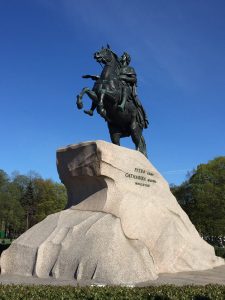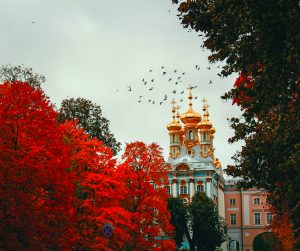95 Russian Domain: Historical Geography II – Who were the Tsars?
Who was the first king in the world? Probably we do not have an answer to that question, for it is likely that such a ruler existed before recorded history. Additionally, we might debate the question of what characteristics are needed for someone to be recognized as a king.
However, we do know who was the first Tsar of Russia. Still, the first rulers of Russia were not known as tsars, nor were the original ruled lands the same as the lands of Russia now. Of course, as we go backwards in time and in historical geography, eventually we find small sections of land that were controlled by powerful men (occasionally women?) of the time. Control, power, size, inheritance, wealth, life expectancy, and other factors produced an ebb and flow of authority or at times the lack thereof.
As it was around the world, eventually somewhere in what now we are calling the Russian Domain, enlarged and recognized central authority was consolidated. In the case of the Russian Domain, this first was Kievan Rus. A group of Slavic lands centralized around Kiev were ruled by Prince Oleg from 892 to 912. Other notable rulers of that time were Grand Prince Vladimir the Great (980-1015) and Grand Prince Yaroslav the Wise (1019-1054). This state broke into pieces throughout the 11th century, saw its authority decreased by a rise in the status of rival city Vladimir, and finally was conquered by the Mongols in the 1240s.
The rise of Vladimir found its apex with the rule of Grand Prince Alexander Nevsky, 1252-1263. Following Nevsky, the Vladimir region also fragmented, eventually creating a new opening to be filled by the rise of Moscow. Through several rulers of the Moscow region, it too paid tribute to the Mongols for numerous years.

In 1533 at the age of three and upon his father’s death, Ivan IV was declared the Grand Prince of Moscow, though regents represented him until 1547. At age sixteen, Ivan was crowned as Tsar of All the Russias, thereby consolidating authority over the lands of Novgorod, Kiev, Vladimir, and Moscow – all the Russian lands.
It was this Ivan whose armies conquered the Mongol forces of the city Kazan in 1552, triggering the end of Mongol control of Russian lands. Ivan sought to expand Russia’s territory, including moving into Siberia. Because of the fearsomeness of Ivan’ rule, he gained the name Ivan the Terrible.
Ivan IV was the first Tsar of Russia, among some thirty such rulers. Some of these Tsars were noteworthy, some barely a footnote in the historical record. But from where did this title come? The word “Tsar” often has been Americanized into the word “Czar.” However, Czar is a poor transliteration of the Russian word and in particular of the Cyrillic letter ц. The Cyrillic word for this royal title is царь. For experts in Russian or Slavic Studies, the Cyrillic letter ц routinely is spelled ts in English. (This is transliteration, the transference of letters or words of one language into the letters or words of a different language, as different than translation, which confers the meaning of words from one language to another.) Thus, in English the word should be spelled “Tsar.” The original derivation of this word goes back to the Roman title “Caesar.”

Photo by Vivian Quam.
Peter I, known to us as Peter the Great, ruled as Tsar from 1682-1725. Both great in physical size and in accomplishments, Peter declared Russia as an empire, thus beginning the use of the term “Emperor” as well as “Tsar.” Standing 6’8” Peter was a giant of the era, at least a foot taller than the average male. In numerous ways, Peter transformed Russia. Peter built the city St. Petersburg on the Baltic Sea and transferred the national capital there from Moscow. He reformed, modernized, and Europeanized his Russian empire. He built the first Russian navy and greatly expanded the territory of the empire.
Catherine II was one of few female Russian monarchs. Catherine the Great ruled from 1762 to 1796, one of the longest reigns of a queen anywhere. Hers was a golden age for Russia, often called the Russian Enlightenment.
Alexander II was in power from 1855 to 1881. His reign was marked by the revolutionary change of the freeing of the serfs from their landlords, giving some 23 million their rights as full citizens of Russia. Ironically, he was assassinated by revolutionaries who felt that he was not progressive enough.
Nicholas II was the last Russian Tsar. Assuming the throne in 1894, he served as Tsar until 1917, when the monarchy was abolished by the Russian Revolution. Nicholas and his family were executed in 1918 by the Bolshevik Communists.

Photo by Emily Ziegler.
Like many kings and queens of countries around the world, the Russian Tsars were known for their opulence, including luxurious palaces. One of these sites, Tsarskoye Selo, features Catherine’s Palace, aka the Summer Palace, and is located outside of St. Petersburg. This photo displays some of the color and beauty of the site, though only a small portion of the property.
Did You Know?
The German word “Kaiser” also comes from the Roman title Caesar.
The novel “Icon” by Frederick Forsyth features the premise of the return of the position of the Tsar as a tactic of disinformation in modern day Russia.
Cited AND additional bibliography:
Vasnetsov, Viktor. 1897. Tsar Ivan The Terrible. https://commons.wikimedia.org/wiki/File:Vasnetsov_Ioann_4.jpg. Public Domain.
Ziegler, Emily. 2020. The Pigeons of Tsarskoye Selo. St. Olaf College, Class of 2022.


